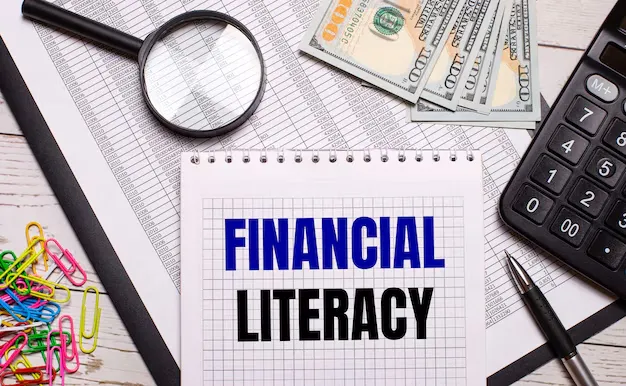Call us today!
Call us today!

Your Health & Wealth
Bodyguard
Our Latest Insights: Blog & Resources

Financial Literacy: Essential Skills Every Teacher Should Know
Introduction
Financial literacy is a crucial skill for educators, providing them with the knowledge and tools to make informed financial decisions. A strong understanding of personal finance not only benefits teachers in their personal lives but also empowers them to educate students on essential financial topics. However, many educators face financial challenges due to a lack of formal training in financial literacy. This article explores why financial literacy is important for teachers, the fundamental financial skills they need, and actionable steps to improve financial well-being.
Why Financial Literacy is Crucial for Educators
1. Ensuring Long-Term Financial Stability
Many teachers rely on pensions for retirement, but these plans may not always provide sufficient income. Without a proper financial plan, educators may struggle to meet future financial obligations, making it essential to supplement their pension with additional savings and investments.
2. Managing Debt Effectively
A significant percentage of teachers graduate with student loan debt, making effective debt management strategies critical. Without financial literacy, educators may struggle with high-interest loans, negatively impacting their long-term financial stability.
3. Reducing Financial Stress
Financial uncertainty can lead to stress and anxiety, affecting job performance and overall well-being. By developing strong financial skills, teachers can gain confidence in managing their money and reducing financial stress.
The Gap in Financial Education for Teachers
Despite their role in shaping future generations, many teachers receive little to no formal financial education. This gap leaves them unprepared to handle personal finances and hinders their ability to teach financial literacy effectively. According to studies, a large percentage of educators feel unprepared to teach financial literacy due to their own lack of knowledge in the subject.
Core Financial Skills for Educators
1. Budgeting and Expense Tracking
Budgeting is the foundation of financial health. Teachers should:
Track monthly expenses to identify spending patterns.
Allocate a portion of income for savings and investments.
Utilize budgeting apps like Mint, YNAB (You Need a Budget), and EveryDollar to manage finances efficiently.
2. Debt Management Strategies
Effective debt management allows educators to free up more money for savings and investments. Key strategies include:
Prioritizing high-interest debt (such as credit cards) while making minimum payments on lower-interest debt.
Refinancing student loans to secure lower interest rates.
Using the snowball or avalanche method to pay off debt efficiently.
Understanding Retirement Accounts
1. 403(b), 457 Plans, and Pension Plans
Teachers often have access to specific retirement plans designed for educators:
403(b) Plans: Tax-deferred savings plans similar to a 401(k), available to public school teachers.
457 Plans: Another tax-advantaged retirement plan, often with fewer withdrawal restrictions.
State Pension Plans: Defined benefit plans that provide a fixed income in retirement based on years of service and salary history.
2. The Impact of Early Withdrawals
Many teachers are unaware of the penalties associated with withdrawing from retirement accounts early. Early withdrawals often come with:
A 10% penalty tax (before age 59½ for most plans).
Significant reduction in long-term savings due to lost compound interest.
Higher taxable income for the year, leading to increased tax liability.
How to Build Wealth on a Teacher’s Salary
1. Smart Saving Strategies
Building wealth does not require a high income; it requires consistency and smart planning. Strategies include:
Automating savings to retirement accounts and high-yield savings accounts.
Setting aside 10-20% of income for future needs.
Taking advantage of employer matching contributions in 403(b) and 457 plans.
2. Passive Income Opportunities
Teachers can supplement their income through passive income streams, such as:
Freelancing & Tutoring: Offering online or in-person tutoring services.
Creating Educational Content: Selling lesson plans or educational resources on platforms like Teachers Pay Teachers.
Investing in Dividend Stocks or Real Estate: Providing an additional income source for retirement planning.
Resources for Improving Financial Literacy
1. Recommended Books and Courses
Books:
"The Total Money Makeover" by Dave Ramsey
"The Simple Path to Wealth" by JL Collins
"Rich Dad Poor Dad" by Robert Kiyosaki
Online Courses:
Next Gen Personal Finance (NGPF): Offers free financial literacy resources for educators.
Khan Academy’s Personal Finance Course: Provides beginner-friendly financial education.
2. Working with a Financial Advisor
A certified financial planner (CFP) can help teachers optimize their retirement plans, manage debt, and make informed investment decisions. Teachers should seek fiduciary advisors who prioritize their clients' best interests.
Final Thoughts
Why Teachers Should Prioritize Financial Education
Teachers serve as role models for students, and their financial habits influence future generations. Understanding personal finance not only benefits educators but also equips them with the knowledge to teach financial literacy effectively.
Steps to Take to Enhance Financial Literacy Today
Assess Your Financial Health: Review income, expenses, debt, and savings.
Set Clear Financial Goals: Define short-term and long-term objectives.
Utilize Free Financial Education Resources: Read books, take courses, and seek professional advice.
Start Investing & Saving Early: Automate contributions and explore passive income opportunities.
Consult a Financial Professional: A financial advisor can help optimize retirement and investment plans.
By developing strong financial literacy skills, educators can secure their financial future, reduce stress, and empower students with the financial knowledge they need to succeed in life.


